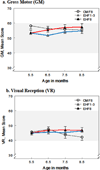Effects of cow milk versus extensive protein hydrolysate formulas on infant cognitive development
- PMID: 26497857
- PMCID: PMC4754137
- DOI: 10.1007/s00726-015-2118-7
Effects of cow milk versus extensive protein hydrolysate formulas on infant cognitive development
Abstract
Little research has focused on infant developmental effects, other than growth, of formulas that differ substantially in the form of protein. To examine development of infants fed formulas differing in free amino acid content, we randomized 0.5-month-old infants (n = 79) to either a control group who fed only cow milk formula (CMF) during the first 8 months (CMF8), or to one of two experimental groups: one experimental group fed extensively protein hydrolyzed formula (EHF) for 1-3 months during first 4.5 months (EHF1-3) of life, and the other fed EHF for 8 months (EHF8). The Mullen Scales of Early Learning were administered monthly from 1.5 to 8.5 months to assess fine (FM) and gross (GM) motor control, receptive (RL) and expressive (EL) language, visual reception (VR), and an early learning composite (ELC). Across the 5.5-8.5-month time period, when compared to CMF8 infants, GM scores in EHF1-3 infants averaged 1.5 points higher (95 % CI 0.1, 3.0) and in EHF8 infants 2.2 points higher (95 % CI 0.3, 4.0). Similarly, VR scores averaged 1.9 points higher (95 % CI 0.1, 3.8) in EHF1-3 infants and 2.2 points higher (95 % CI -0.2, 4.5) in EHF8 infants. EHF8 infants' RL scores averaged 1.8 points lower (95 % CI 0.1, 3.6) than CMF8 infants. These data suggest that the form of protein in infant formula may impact cognitive development and that the higher free amino acid content in breast milk may be a contributing factor to the differential cognitive development between breastfed and CMF-fed infants.
Clinical trial registration: clinicaltrials.gov NCT00994747.
Keywords: Cognitive development; Cow milk formula; Extensive protein hydrolysate formula; Free amino acids.
Conflict of interest statement
Disclosure
JAM, JCT, and MAP report no conflicts of interest.
Figures

References
-
- Agostoni C, Carratu B, Boniglia C, Riva E, Sanzini E. Free amino acid content in standard infant formulas: comparison with human milk. J Am Coll Nutr. 2000;19:434–438. - PubMed
-
- Andres A, Cleves MA, Bellando JB, Pivik RT, Casey PH, Badger TM. Developmental status of 1-year-old infants fed breast milk, cow's milk formula, or soy formula. Pediatrics. 2012;129:1134–1140. - PubMed
-
- Auestad N, Scott DT, Janowsky JS, Jacobsen C, Carroll RE, Montalto MB, Halter R, Qiu W, Jacobs JR, Connor WE, Connor SL, Taylor JA, Neuringer M, Fitzgerald KM, Hall RT. Visual, cognitive, and language assessments at 39 months: a follow-up study of children fed formulas containing long-chain polyunsaturated fatty acids to 1 year of age. Pediatrics. 2003;112:e177–e183. - PubMed
-
- Brosnan, JT and Brosnan ME. The sulfur-containing amino acids: an overview. J Nutr. 2006;136:1636S–1640S. - PubMed
Publication types
MeSH terms
Substances
Associated data
Grants and funding
LinkOut - more resources
Full Text Sources
Other Literature Sources
Medical

